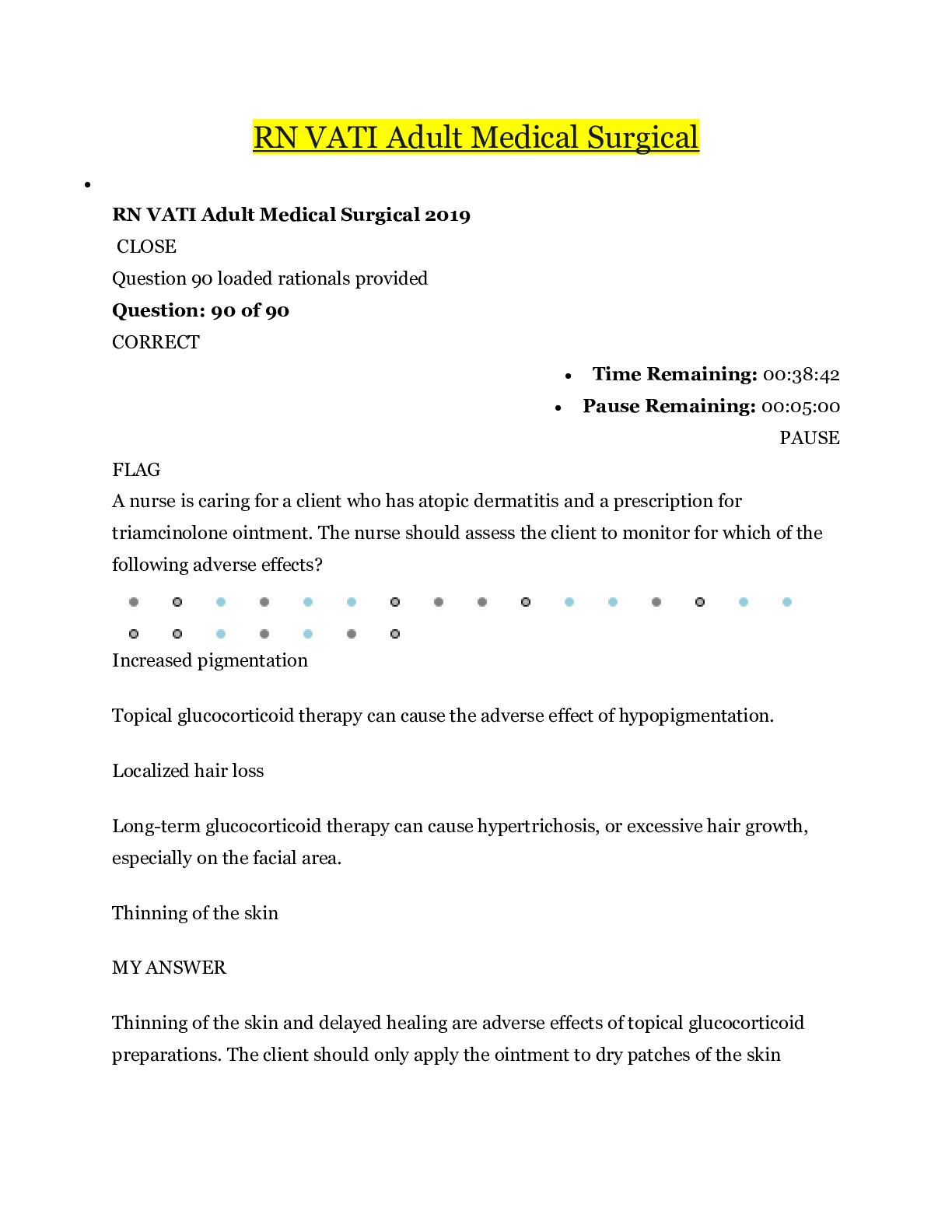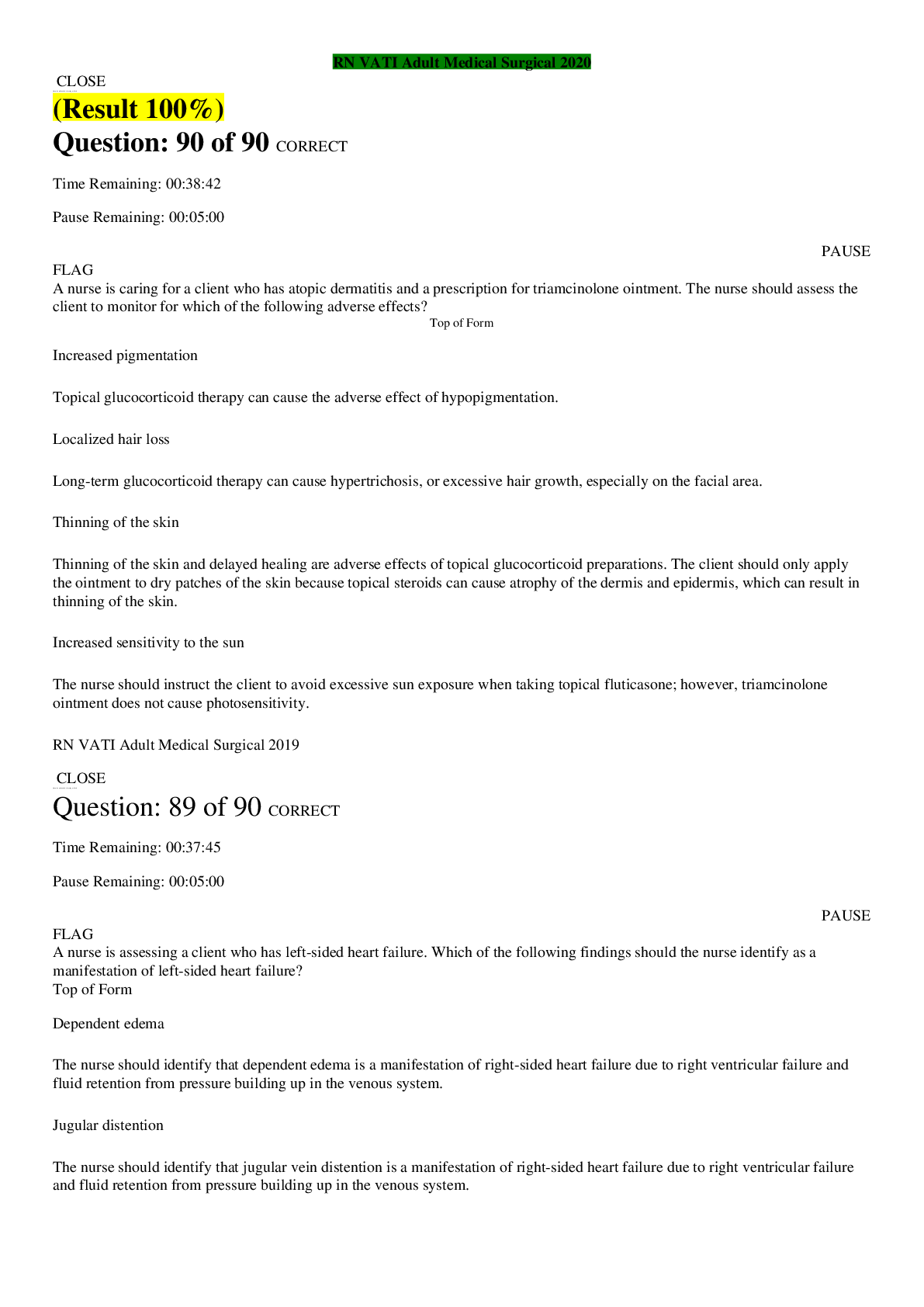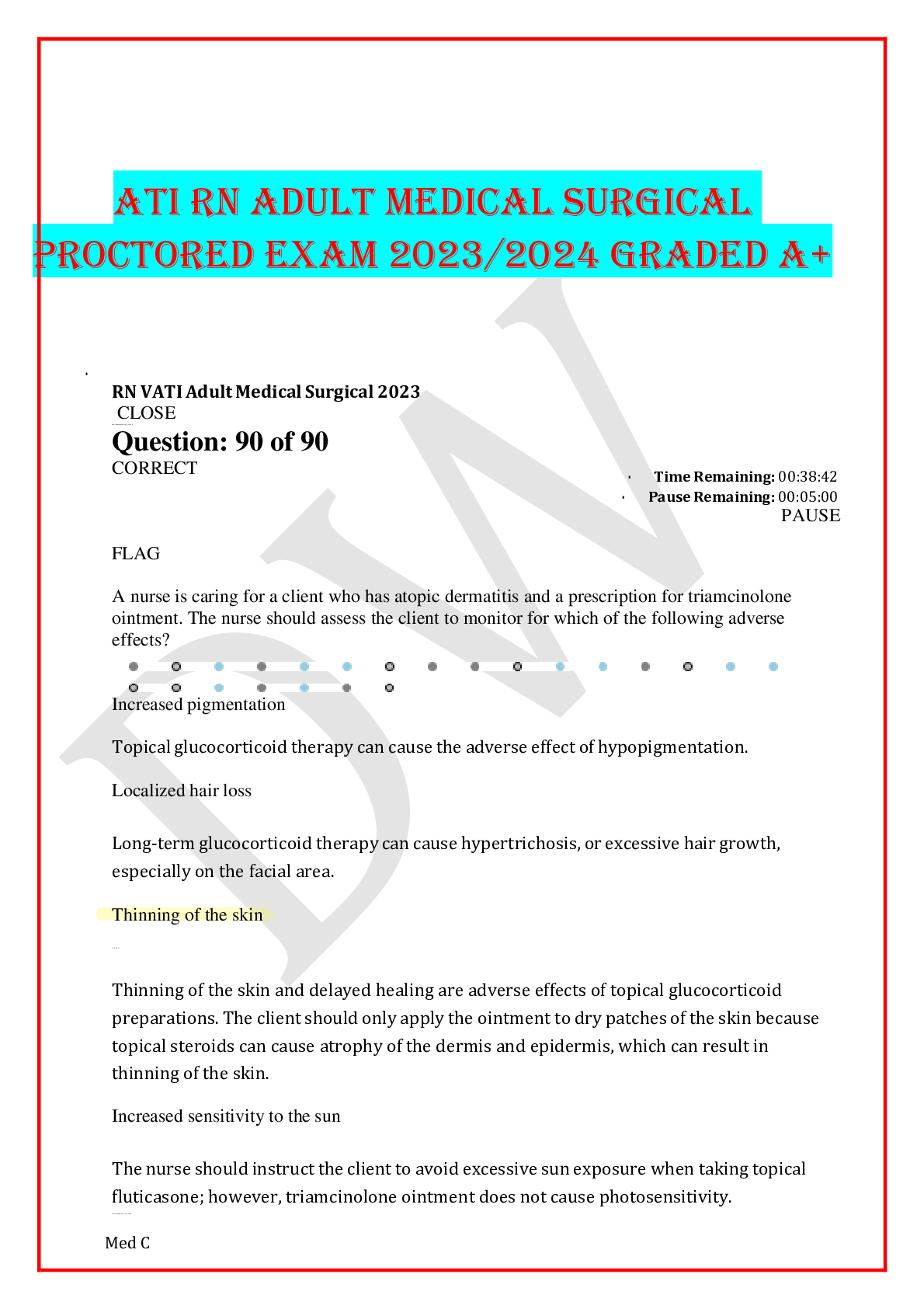*NURSING > VATI RN > RN VATI Adult Medical Surgical 2019_Graded A | Adult Medical Surgical 2019 (All)
RN VATI Adult Medical Surgical 2019_Graded A | Adult Medical Surgical 2019
Document Content and Description Below
RN VATI Adult Medical Surgical 2019_Graded A Question: 90 of 90 CORRECT FLAG A nurse is caring for a client who has atopic dermatitis and a prescription for triamcinolone ointment... . The nurse should assess the client to monitor for which of the following adverse effects? Increased pigmentation Topical glucocorticoid therapy can cause the adverse effect of hypopigmentation. Localized hair loss Long-term glucocorticoid therapy can cause hypertrichosis, or excessive hair growth, especially on the facial area. Thinning of the skin MY ANSWER Thinning of the skin and delayed healing are adverse effects of topical glucocorticoid preparations. The client should only apply the ointment to dry patches of the skin because topical steroids can cause atrophy of the dermis and epidermis, which can result in thinning of the skin. Increased sensitivity to the sun The nurse should instruct the client to avoid excessive sun exposure when taking topical fluticasone; however, triamcinolone ointment does not cause photosensitivity. • RN VATI Adult Medical Surgical 2019 CLOSE Question 89 loaded rationals provided Question: 89 of 90 CORRECT FLAG • Time Remaining: 00:37:45 • Pause Remaining: 00:05:00 PAUSE A nurse is assessing a client who has left-sided heart failure. Which of the following findings should the nurse identify as a manifestation of left-sided heart failure? Dependent edema The nurse should identify that dependent edema is a manifestation of right- sided heart failure due to right ventricular failure and fluid retention from pressure building up in the venous system. Jugular distention The nurse should identify that jugular vein distention is a manifestation of right-sided heart failure due to right ventricular failure and fluid retention from pressure building up in the venous system. Weight gain The nurse should identify that weight gain is a manifestation of right-sided heart failure due to right ventricular failure and fluid retention from pressure building up in the venous system. Frothy sputum MY ANSWER The nurse should identify that frothy sputum, dyspnea, and wheezing are manifestations of left-sided heart failure. Treatment includes fluid restriction and diuretics to decrease preload and reduce pulmonary congestion. Pink- tinged frothy sputum can be an early indication of pulmonary edema and can be life-threatening. Therefore, the nurse should notify the provider immediately. • RN VATI Adult Medical Surgical 2019 CLOSE Question 88 loaded rationals provided Question: 88 of 90 CORRECT FLAG • Time Remaining: 00:37:30 • Pause Remaining: 00:05:00 PAUSE A nurse is caring for a client who is experiencing anxiety as well as numbness and tingling of the lips and fingers. The client's ABGs are: pH 7.48, PCO2 30 mm Hg, HCO3- 24 mEq/L, PaO2 85 mm Hg. Which of the following acid-base imbalances should the nurse identify that the client is experiencing? Respiratory alkalosis MY ANSWER This pH is alkaline (increased) and the PCO2 is decreased, representing alveolar hyperventilation and resultant respiratory alkalosis. Respiratory acidosis This pH is alkaline (increased) and the PCO2 is decreased. A decreased pH and an increased PCO2 indicate respiratory acidosis. Metabolic alkalosis This HCO - 24 mEq/L is within the expected range of 21 to 28 mEq/L and the pH is alkaline (increased). An increased pH and HCO - indicate metabolic alkalosis. Metabolic acidosis This HCO - 24 mEq/L is within the expected range of 21 to 28 mEq/L and the pH is alkaline (increased). A decreased pH and HCO - indicate metabolic acidosis. • RN VATI Adult Medical Surgical 2019 CLOSE Question 87 loaded rationals provided Question: 87 of 90 CORRECT FLAG • Time Remaining: 00:37:22 • Pause Remaining: 00:05:00 PAUSE A nurse is assessing a client who has Cushing's syndrome. Which of the following findings should the nurse expect? Vitiligo Vitiligo is the loss of pigment from areas of a client's skin, causing irregular, white patches. Vitiligo is a manifestation of adrenal-gland hypofunction. Osteoporosis MY ANSWER Osteoporosis is a common finding with Cushing's syndrome. Bones become thinner as a result of mineral loss and nitrogen depletion, and the risk for fractures increases. Myxedema A client who has hypothyroidism can develop myxedema that causes mucinous cellular edema around the eyes, across the upper back, and in the hands and feet. Heat intolerance A client who has hyperthyroidism can develop heat intolerance, along with an increase in sweating. • RN VATI Adult Medical Surgical 2019 CLOSE Question 86 loaded rationals provided Question: 86 of 90 CORRECT FLAG • Time Remaining: 00:37:13 • Pause Remaining: 00:05:00 PAUSE A nurse is inspecting the skin of a client who has basal cell carcinoma. The nurse should identify which of the following lesion characteristics on the client's skin? A pearly, waxy nodule MY ANSWER A client who has basal cell carcinoma has a nodular lesion with well-defined borders and a pearly or waxy appearance, resulting from overexposure to the sun, especially on the face, head, and neck. An irregular border on a variegated-colored lesion A client who has melanoma has a lesion with irregular borders and variegated colors of red, white, and blue, most often on the upper back or lower legs. A firm, nodular, crusty, or ulcerated lesion A client who has squamous cell carcinoma has a firm, nodular, and crusty lesion with an ulcerated center, resulting from sun exposure, chronic irritation, burns, or irradiation to the skin. A weeping vesicle A client who has herpes zoster has weeping, blister-type lesions. • RN VATI Adult Medical Surgical 2019 CLOSE Question 85 loaded rationals provided Question: 85 of 90 CORRECT FLAG • Time Remaining: 00:37:02 • Pause Remaining: 00:05:00 PAUSE A nurse is assessing a client who has hypocalcemia. In which of the following areas should the nurse tap on the client's face to detect the presence of Chvostek's sign? (You will find hot spots to select in the artwork below. Select only the hot spot that corresponds to your answer.) A is correct. The nurse should tap the client's cheek just in front of the ear and below the zygomatic arch. The client who has hypocalcemia will display a Chvostek's sign, which is a twitching of the facial muscle. B is incorrect. The nurse should apply upward pressure at the supraorbital ridge, below the eyebrow, to assess for tenderness and inflammation of the frontal sinuses. C is incorrect. The nurse should palpate the jaw and mastoid muscle of a client who has temporomandibular joint dysfunction. This can be caused by misaligned teeth, arthritis, or grinding of the teeth. With palpation, the nurse might feel a click, pop, or grating sensation when the client opens or closes the jaw. • RN VATI Adult Medical Surgical 2019 CLOSE Question 84 loaded rationals provided Question: 84 of 90 CORRECT FLAG • Time Remaining: 00:36:55 • Pause Remaining: 00:05:00 PAUSE A nurse in an emergency department is assessing a client who is overusing prescribed diuretics and has a sodium level of 127 mEq/L. Which of the following laboratory findings should the nurse expect? High lipase A high lipase level is associated with pancreatic dysfunction or renal failure and is not an expected finding with hyponatremia or dehydration. Low urine specific gravity MY ANSWER A client who has hyponatremia as a result of diuretic overuse has a low urine specific gravity. The increased excretion of water alters the ratio of particulate matter, which affects the specific gravity. Low hemoglobin A client who is dehydrated as a result of diuretic overuse can have an elevated hemoglobin level because of the difference in ratio between intravascular fluid and blood cells. High creatine kinase-MB (CK-MB) An elevated CK-MB level indicates a myocardial infarction and is not an expected finding with hyponatremia. • RN VATI Adult Medical Surgical 2019 CLOSE Question 83 loaded rationals provided Question: 83 of 90 INCORRECT FLAG • Time Remaining: 00:36:47 • Pause Remaining: 00:05:00 PAUSE A home health nurse is assisting a client with planning care for a family member who has Alzheimer's disease. Which of the following instructions should the nurse include? Remove clutter from rooms and hallways. The nurse should instruct the family member to remove clutter from rooms and hallways so the client is able to walk without the risk of falling or tripping over objects. Later in the disease, the client can experience seizures, so cluttered areas could be a risk to the client. Place a monthly calendar in the client's room. [Show More]
Last updated: 1 year ago
Preview 1 out of 192 pages
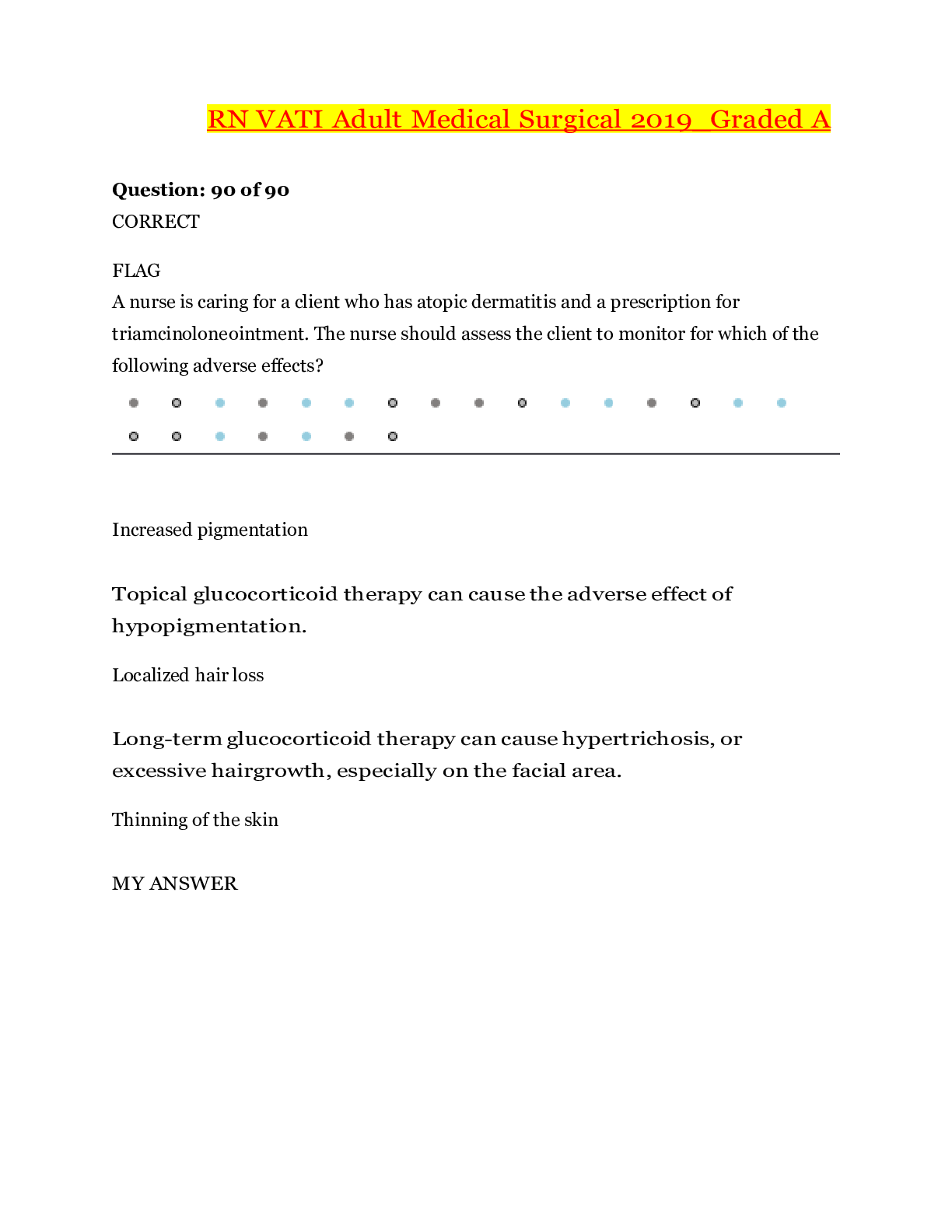
Reviews( 0 )
Document information
Connected school, study & course
About the document
Uploaded On
Apr 15, 2021
Number of pages
192
Written in
Additional information
This document has been written for:
Uploaded
Apr 15, 2021
Downloads
0
Views
61

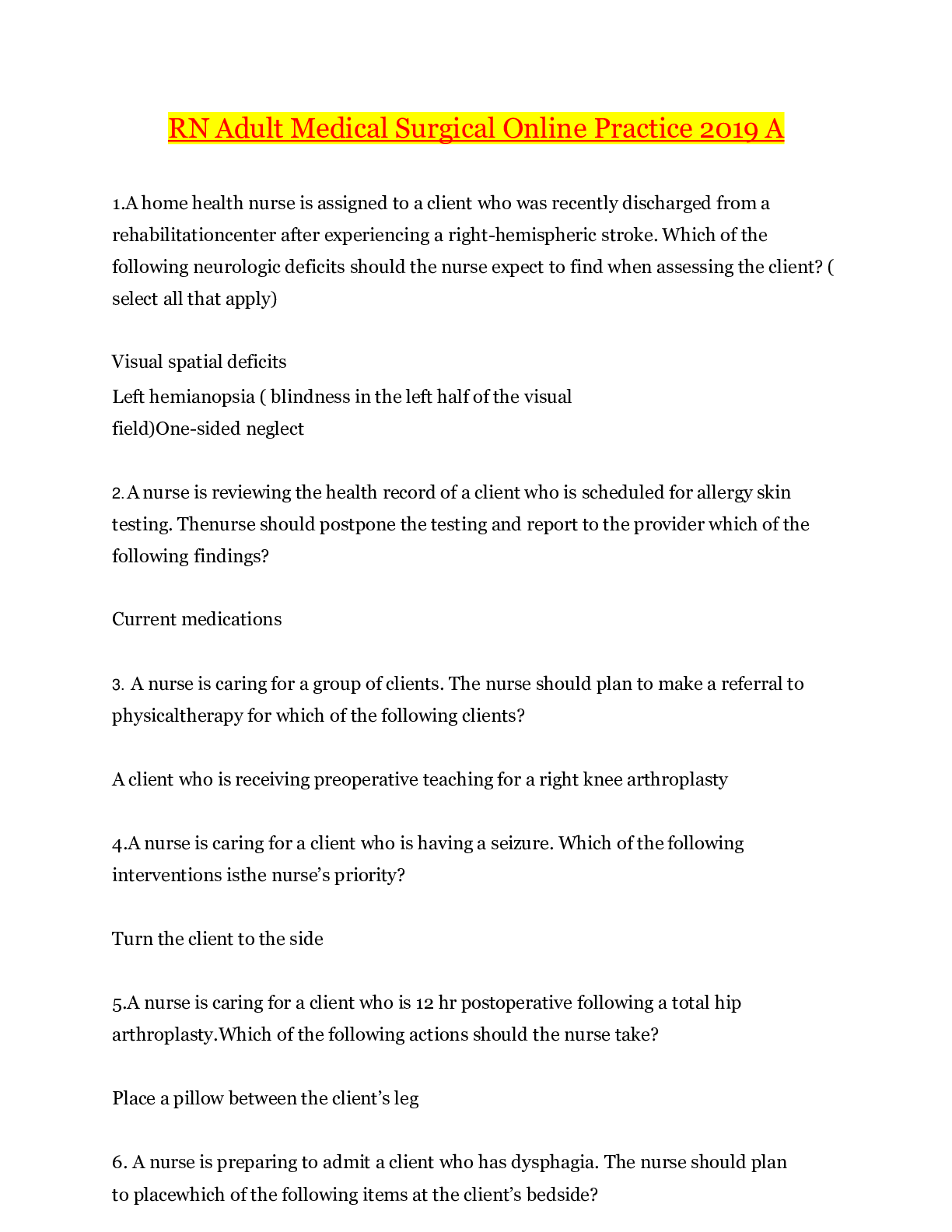
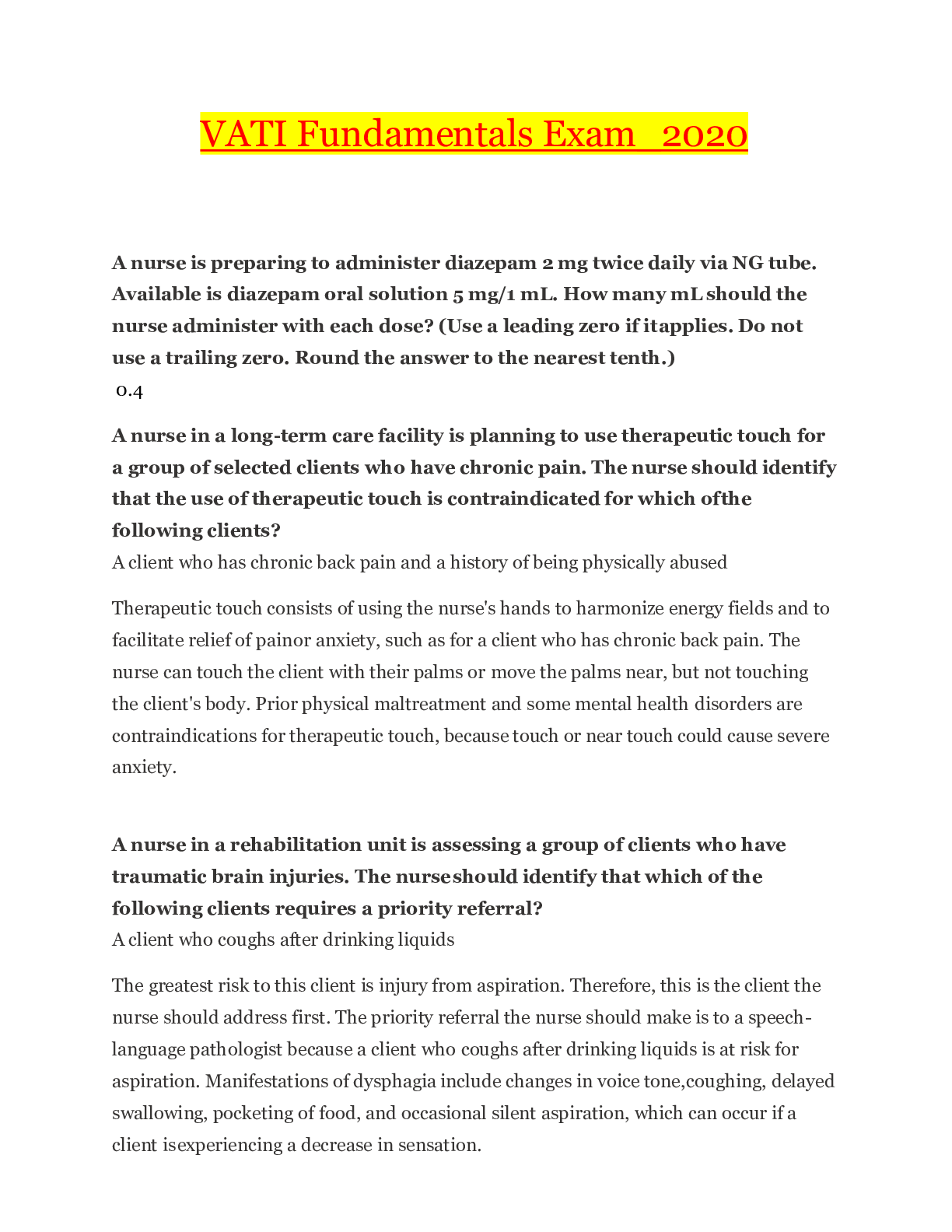

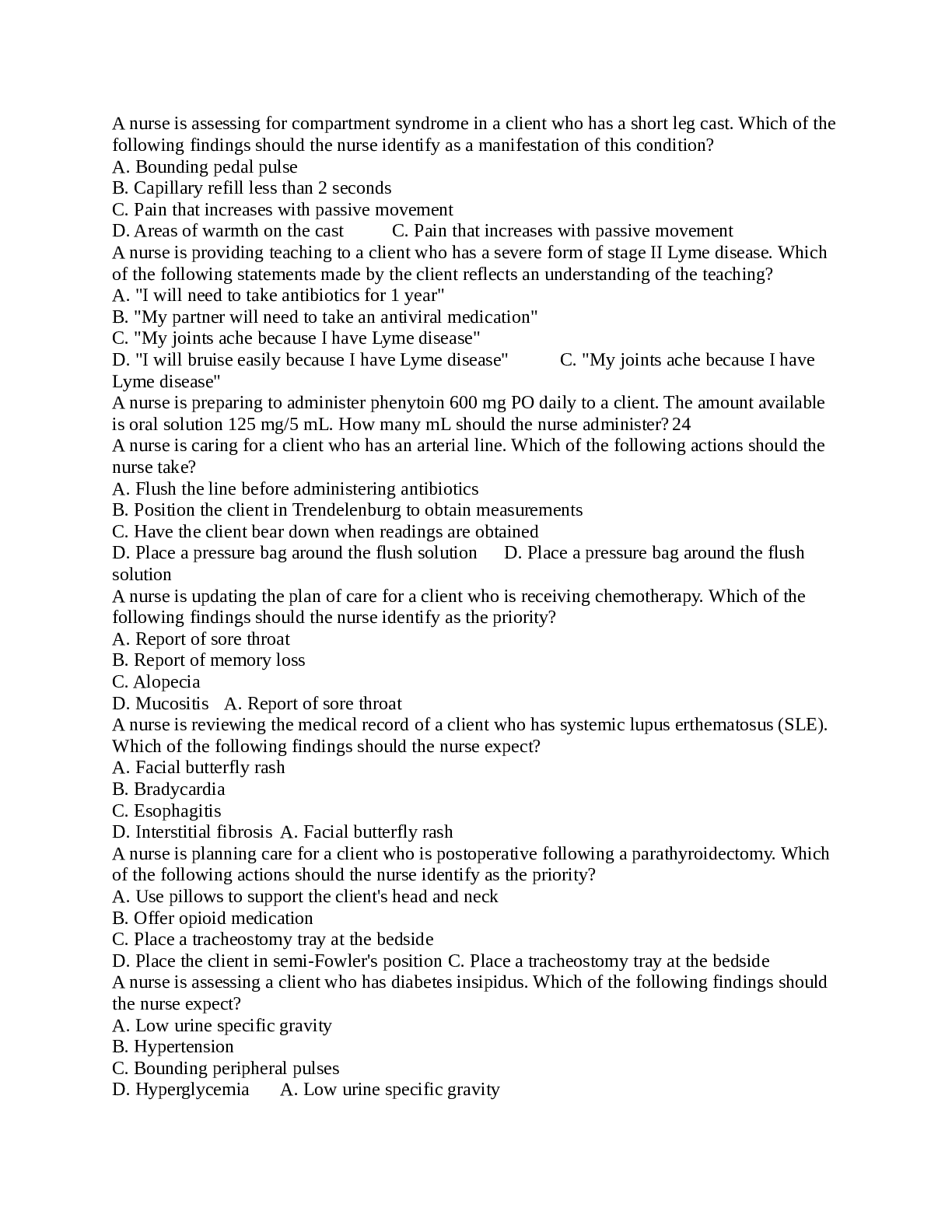
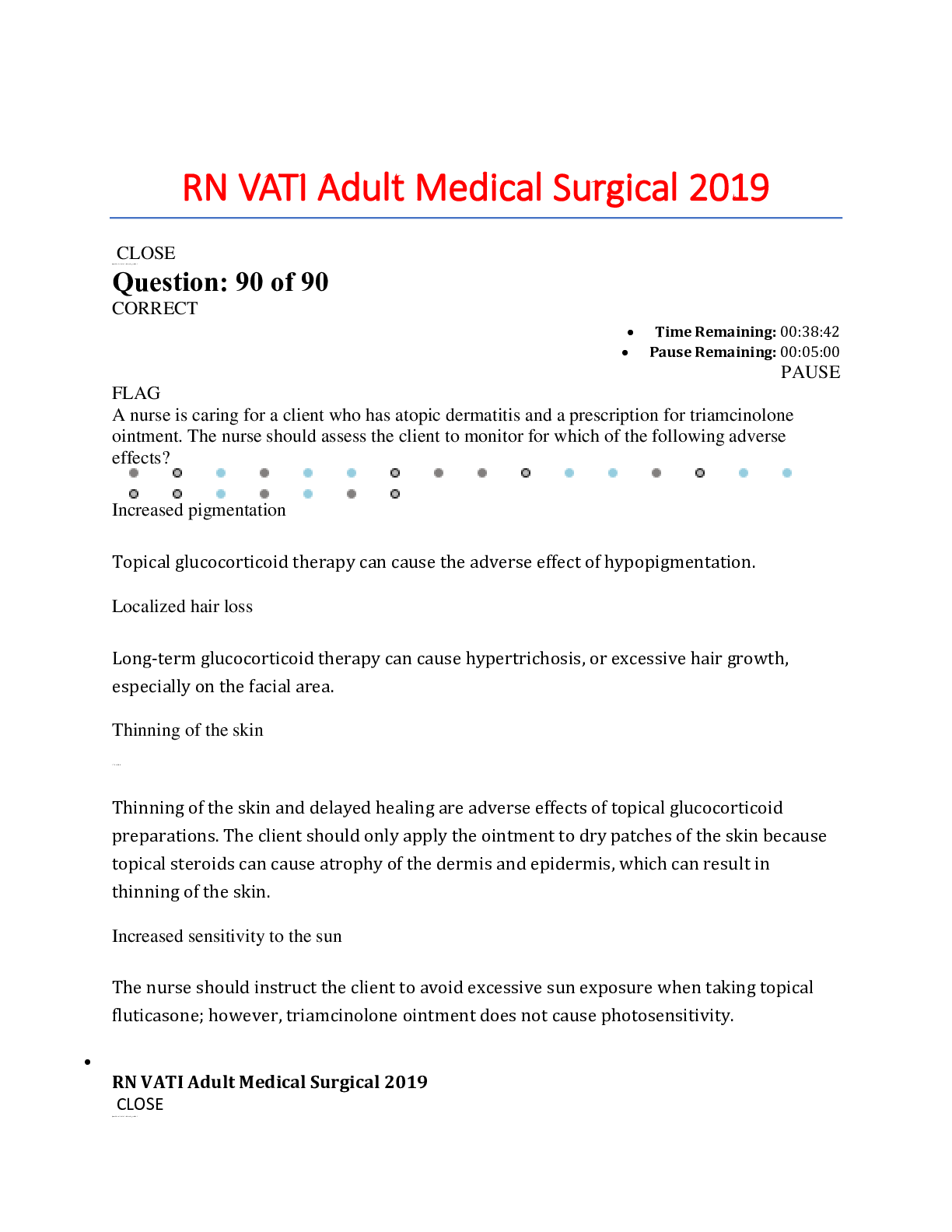

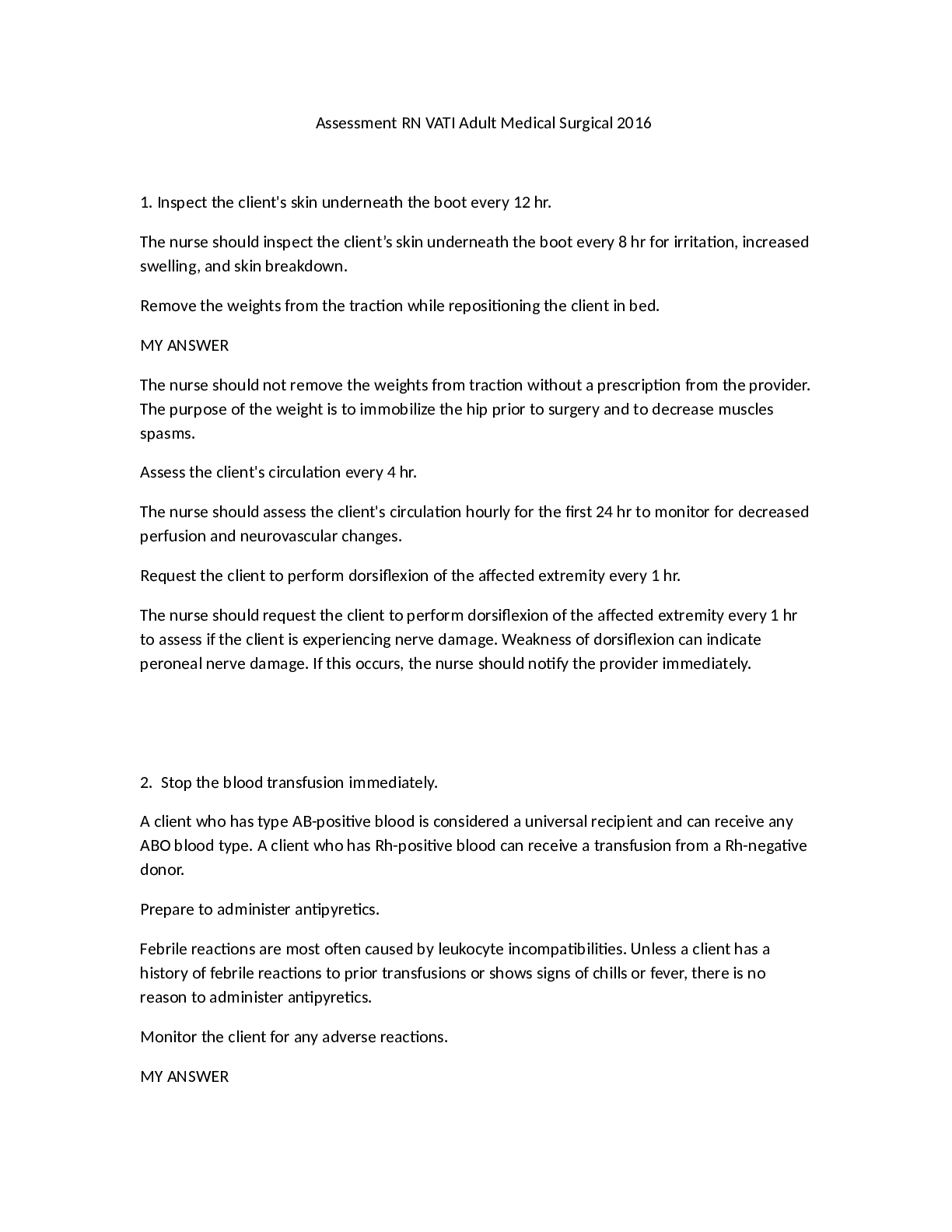
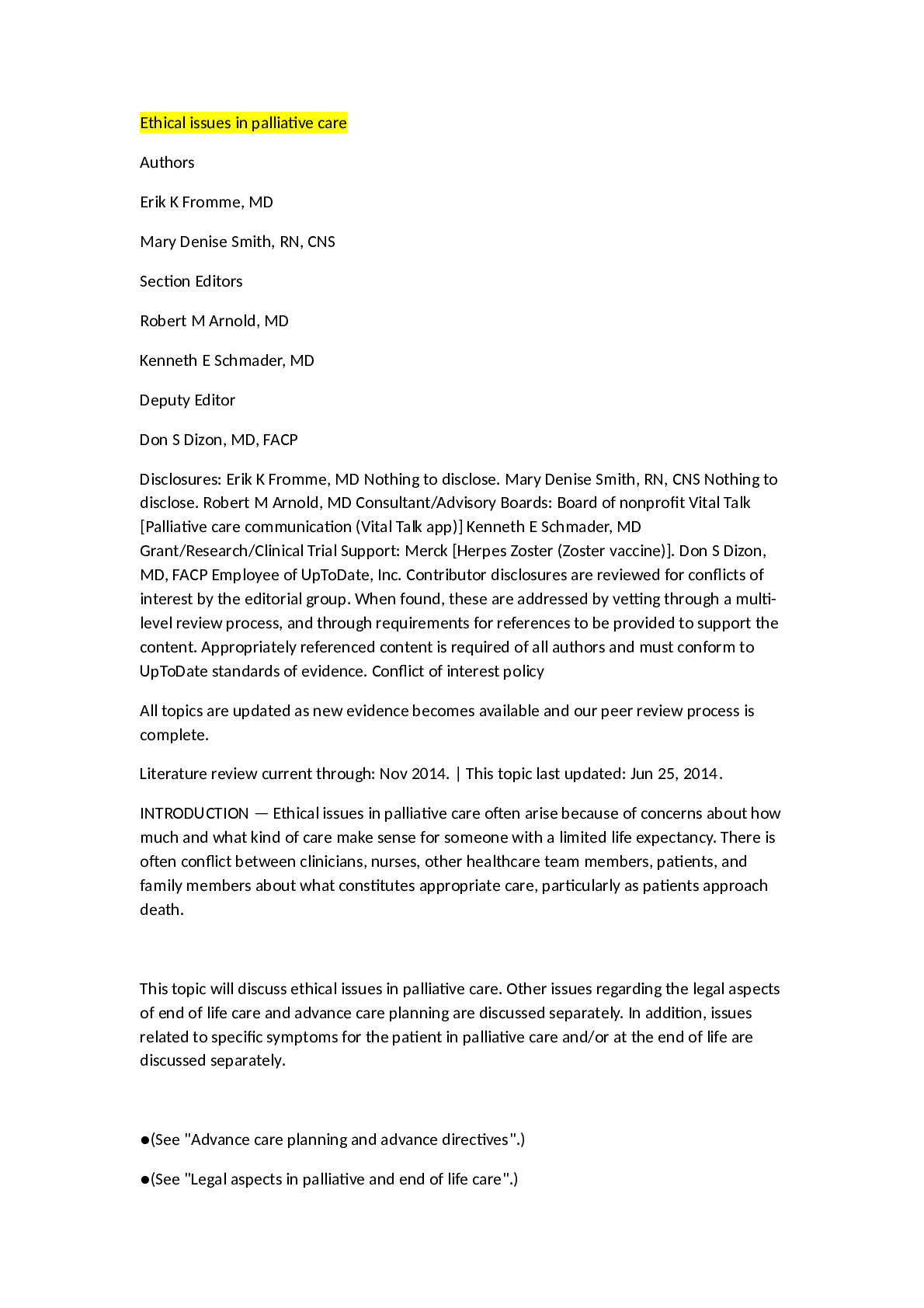
 Verified Questions and Answers Exam Guide.png)
